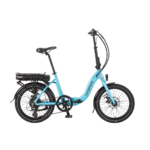"stokemonkey" my Tongxin?
- Thread starter kitchenman
- Start date
Yes, just use a chainwheel, or spider for mounting chainrings, then fit directly on. Most use square taper mounting, identical on both sides, I'm certain that's one.
P.S. I'd recommend a spider for this application, since it will give the most flexibility for changing the ratios by using different size chainrings as well as different size motor sprockets.
They come with 3, 4 or 5 arms on which the rings mount, and for this I'd recommend a 5 type for the greatest stability under power.
This website will give you the dimensional information you need to get the right spider and rings, Click "Cycle Information" in the side bar, then under general information click "Cranks and Chainsets".
.
P.S. I'd recommend a spider for this application, since it will give the most flexibility for changing the ratios by using different size chainrings as well as different size motor sprockets.
They come with 3, 4 or 5 arms on which the rings mount, and for this I'd recommend a 5 type for the greatest stability under power.
This website will give you the dimensional information you need to get the right spider and rings, Click "Cycle Information" in the side bar, then under general information click "Cranks and Chainsets".
.
Last edited:
Should work, there are three potential issues that might be a problem but it is really a case of try it and see how it goes! :
1) Sometimes the rh side of a bb axle is slightly longer to allow for the fitment of the chainwheel - putting it on the LH side would put the chainwheel closer to the chainstay tube and it might hit it and need spaced to give clearance
2) Often the rh chainstay is a slightly different shape - it has a dent in it to make clearance for the chainwheels, though with a single chainwheel this may not be an issue
3) With the crank on the LH side the LH pedal will have the opposite thread to what it would normally have. Usually the rh pedal has a r thread and the lh pedal a lh thread. it might therefore make the lh pedal want to unscrew itself, but this could be overcome by threadlocking it and doing it up well.
Hope this helps
1) Sometimes the rh side of a bb axle is slightly longer to allow for the fitment of the chainwheel - putting it on the LH side would put the chainwheel closer to the chainstay tube and it might hit it and need spaced to give clearance
2) Often the rh chainstay is a slightly different shape - it has a dent in it to make clearance for the chainwheels, though with a single chainwheel this may not be an issue
3) With the crank on the LH side the LH pedal will have the opposite thread to what it would normally have. Usually the rh pedal has a r thread and the lh pedal a lh thread. it might therefore make the lh pedal want to unscrew itself, but this could be overcome by threadlocking it and doing it up well.
Hope this helps
D
Deleted member 4366
Guest
Make sure that you get the square at the correct angle in your new chain-wheel/spider - diamond or square - otherwise your pedals won't be 180 deg apart. Theoretically, the pedal could unscrew itself, because it'll have a right-hand thread instead of the normal left hand one, so make sure it's screwed up nice and tight.
Ogoi just reminded me. I had to fit a much longer BB spindle in mine. to get a single chainwheel clear of the chainstay. I think about 131mm.
Ogoi just reminded me. I had to fit a much longer BB spindle in mine. to get a single chainwheel clear of the chainstay. I think about 131mm.
Last edited by a moderator:
Is this business about pedal threads correct?
Unless I am mistaken, with the current set up, any seizure in the pedal would cause it to undo, not tighten up?
Unless I am mistaken, with the current set up, any seizure in the pedal would cause it to undo, not tighten up?
d8veh wrote "Theoretically, the pedal could unscrew itself," I think he meant the crank could unscrew itself ... cause obviously the lh pedal has a left hand screw . Then I think it makes sense . ---- no thats not right! ...Is this business about pedal threads correct?
Unless I am mistaken, with the current set up, any seizure in the pedal would cause it to undo, not tighten up?
He means that the new crank that I fit will have to have a new crank arm and pedal and that it'll have to be a right hand thread? ....
Last edited:
That is true Mike. The reason for the pedal threads being the way they are is that under normal operating conditions the natural reaction of the inner race of a bearing is to turn the opposite way to the outer race, hence for the rh pedal the outer race is turning anticlockwise and the reaction of the pedal shaft with the inner race on it is to want to turn clockwise and hence tighten itself.
This can be seen working in a similar way with a bb bearing as well. A rh bb outer race has a lh thread, the bb axle when seen from the rh side of the bike, is turning clockwise, the reaction of the outer race is to turn anticlockwise and so tighten itself
This can be seen working in a similar way with a bb bearing as well. A rh bb outer race has a lh thread, the bb axle when seen from the rh side of the bike, is turning clockwise, the reaction of the outer race is to turn anticlockwise and so tighten itself
Just to clarify flecc! .... Do I keep the crank arm and pedal or do I change the lot?Yes, just use a chainwheel, or spider for mounting chainrings, then fit directly on. Most use square taper mounting, identical on both sides, I'm certain that's one.
P.S. I'd recommend a spider for this application, since it will give the most flexibility for changing the ratios by using different size chainrings as well as different size motor sprockets.
They come with 3, 4 or 5 arms on which the rings mount, and for this I'd recommend a 5 type for the greatest stability under power.
This website will give you the dimensional information you need to get the right spider and rings, Click "Cycle Information" in the side bar, then under general information click "Cranks and Chainsets".
.
The type of spider you need consists of a new crank arm integral with the centre part and arms, so you onkly need to swap over the pedal. As d8veh warned, make sure the central square taper hole orientation is correct to leave the crank opposite at 180 degrees to the existing right hand one. Here's a pic of one, in this case with a belt ring bolted to the spider. Yours will be a chain ring of course:


Thanks - perrrrrfectly clear now ...The type of spider you need consists of a new crank arm integral with the centre part and arms, so you onkly need to swap over the pedal. As d8veh warned, make sure the central square taper hole orientation is correct to leave the crank opposite at 180 degrees to the existing right hand one. Here's a pic of one, in this case with a belt ring bolted to the spider. Yours will be a chain ring of course:

Thanks Andy. I'll suck it and see and then get one if I need to. Good to know though. I did have a fleeting thought something along the lines of " I wonder if they do cranks with a lh thread .. no .. that would be silly" ... just goes to show you should never stop thinking! ... might add this to my signature: my wife thinks I'm obsessed but I just think a lot
D
Deleted member 4366
Guest
I've just ordered one of these for my next project. It allows the chain-wheels to free-wheel independently from the pedals. I believe that both chain-wheels together with one connected to the motor.It requires taking the drive off the right side of the motor:
Worlds best Electric bicycle recumbent DIY conversion kits kit NuVinci Electric Scooter e-bike worlds best Electric bicycle recumbent DIY conversion kits kit Worlds best Electric bicycle recumbent DIY conversion kits kit NuVinci Electric Scooter e-bi
Scroll to the bottom. Worked out at about £60
Worlds best Electric bicycle recumbent DIY conversion kits kit NuVinci Electric Scooter e-bike worlds best Electric bicycle recumbent DIY conversion kits kit Worlds best Electric bicycle recumbent DIY conversion kits kit NuVinci Electric Scooter e-bi
Scroll to the bottom. Worked out at about £60
Attachments
-
15.1 KB Views: 15
Last edited by a moderator:
Crank with a free wheel would be great for me. With a freewheel I would have to button press for assistance. The freewheel means that my pedal sensor can be used .. which would be nice.. However, I'm driving the crank from the lhs.. which is a shame.. dont suppose anyone has built a "normal" freewheel crank? ...It allows the chain-wheels to free-wheel independently from the pedals. I believe that both chain-wheels together with one connected to the motor.It requires taking the drive off the right side of the motor
D
Deleted member 4366
Guest
To make one, you need access to a centre lathe. You pull the chain-wheel off the crank arm, which leaves a spline. Turn the spline to a plain boss of the correct diameter and then cut the thread for a free-wheel. Then you screw on a free-wheel. Weld a bigger chain-wheel to the teeth if you want more than 22 teeth.
Look at posts #59 onwards. You can buy that free-wheel from Sickbikeparts and you can even buy the pedals with the free-wheel thread already done:http://www.pedelecforum.de/forum/showthread.php?3405-Ideen-zum-Bau-eines-neuen-E-Bikes/page4
Sick Bike Parts
Sick Bike Parts
Look at posts #59 onwards. You can buy that free-wheel from Sickbikeparts and you can even buy the pedals with the free-wheel thread already done:http://www.pedelecforum.de/forum/showthread.php?3405-Ideen-zum-Bau-eines-neuen-E-Bikes/page4
Sick Bike Parts
Sick Bike Parts
Great stuff. Thanks.To make one, you need access to a centre lathe. You pull the chain-wheel off the crank arm, which leaves a spline. Turn the spline to a plain boss of the correct diameter and then cut the thread for a free-wheel. Then you screw on a free-wheel. Weld a bigger chain-wheel to the teeth if you want more than 22 teeth ...
I will get one of these Flecc. But for £8 quid I took a chance and got something that fits and will allow me to get one. Having 2 rings and 2 chain lines to choose from may be useful! ...

btw - didn't know the size restriction on .jpg files had been lifted. Didn't need to convert this 1.37 mb file - nice enhancement to the forum.

btw - didn't know the size restriction on .jpg files had been lifted. Didn't need to convert this 1.37 mb file - nice enhancement to the forum.
This mornings work:
Crank_sunday_am - a set on Flickr
Drilling and hacksawing "forks" and the initial mounting....
Now on a lunch break and then its ... another mount and photos this time with a sprocket to show that it fits! .. .... and start planning and doing the electrics swap over ...
Crank_sunday_am - a set on Flickr
Drilling and hacksawing "forks" and the initial mounting....
Now on a lunch break and then its ... another mount and photos this time with a sprocket to show that it fits! .. .... and start planning and doing the electrics swap over ...
and the afternoon session:
Crank_afternoon - a set on Flickr
There is just enough room for the chain even with my hefty forks.
Tonight I will see if I can fit some of the cables and switches ....the current lighting system which I am going to keep routes through the frame. I wonder if I can do the same? ...i.e. use the current cabling as a guide to pull the other cables though? ... Umm ... could be dangerous .... and advice?
Crank_afternoon - a set on Flickr
There is just enough room for the chain even with my hefty forks.
Tonight I will see if I can fit some of the cables and switches ....the current lighting system which I am going to keep routes through the frame. I wonder if I can do the same? ...i.e. use the current cabling as a guide to pull the other cables though? ... Umm ... could be dangerous .... and advice?
Last edited:
Related Articles
-
 MTF Enterprises announces acquisition of EMU Electric Bikes
MTF Enterprises announces acquisition of EMU Electric Bikes- Started by: Pedelecs
-
 Wisper 806T folding bike wins Which? ‘Best Buy’
Wisper 806T folding bike wins Which? ‘Best Buy’- Started by: Pedelecs
-
 Sustrans calls for protected cycle lanes
Sustrans calls for protected cycle lanes- Started by: Pedelecs
-
 Amazon launch their first UK e-cargo micromobility hub
Amazon launch their first UK e-cargo micromobility hub- Started by: Pedelecs




